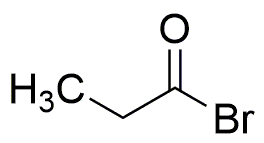Propionyl bromide is widely utilized in research focused on:
- Synthesis of Esters: It serves as an important reagent in the synthesis of propionyl esters, which are used in the production of various flavors and fragrances.
- Pharmaceutical Development: This compound is employed in the synthesis of pharmaceutical intermediates, aiding in the development of new medications with enhanced efficacy.
- Organic Synthesis: It acts as an acylating agent in organic reactions, facilitating the introduction of propionyl groups into various organic compounds, thus expanding the chemical library for researchers.
- Polymer Chemistry: Propionyl bromide is used in the modification of polymers, improving their properties for applications in coatings and adhesives.
- Analytical Chemistry: It is utilized in the derivatization of alcohols and amines, enhancing their detection and quantification in analytical methods such as gas chromatography.
General Information
Properties
Safety and Regulations
Applications
Propionyl bromide is widely utilized in research focused on:
- Synthesis of Esters: It serves as an important reagent in the synthesis of propionyl esters, which are used in the production of various flavors and fragrances.
- Pharmaceutical Development: This compound is employed in the synthesis of pharmaceutical intermediates, aiding in the development of new medications with enhanced efficacy.
- Organic Synthesis: It acts as an acylating agent in organic reactions, facilitating the introduction of propionyl groups into various organic compounds, thus expanding the chemical library for researchers.
- Polymer Chemistry: Propionyl bromide is used in the modification of polymers, improving their properties for applications in coatings and adhesives.
- Analytical Chemistry: It is utilized in the derivatization of alcohols and amines, enhancing their detection and quantification in analytical methods such as gas chromatography.
Documents
Safety Data Sheets (SDS)
The SDS provides comprehensive safety information on handling, storage, and disposal of the product.
Product Specification (PS)
The PS provides a comprehensive breakdown of the product’s properties, including chemical composition, physical state, purity, and storage requirements. It also details acceptable quality ranges and the product's intended applications.
Certificates of Analysis (COA)
Search for Certificates of Analysis (COA) by entering the products Lot Number. Lot and Batch Numbers can be found on a product’s label following the words ‘Lot’ or ‘Batch’.
*Catalog Number
*Lot Number
Certificates Of Origin (COO)
This COO confirms the country where the product was manufactured, and also details the materials and components used in it and whether it is derived from natural, synthetic, or other specific sources. This certificate may be required for customs, trade, and regulatory compliance.
*Catalog Number
*Lot Number
Safety Data Sheets (SDS)
The SDS provides comprehensive safety information on handling, storage, and disposal of the product.
DownloadProduct Specification (PS)
The PS provides a comprehensive breakdown of the product’s properties, including chemical composition, physical state, purity, and storage requirements. It also details acceptable quality ranges and the product's intended applications.
DownloadCertificates of Analysis (COA)
Search for Certificates of Analysis (COA) by entering the products Lot Number. Lot and Batch Numbers can be found on a product’s label following the words ‘Lot’ or ‘Batch’.
*Catalog Number
*Lot Number
Certificates Of Origin (COO)
This COO confirms the country where the product was manufactured, and also details the materials and components used in it and whether it is derived from natural, synthetic, or other specific sources. This certificate may be required for customs, trade, and regulatory compliance.


